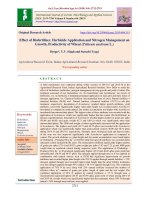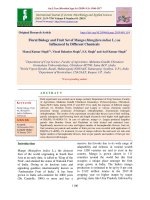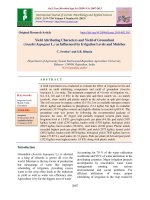Productivity of potato (Solanum tuberosum L.) as influenced by calcium metalosate
Bạn đang xem bản rút gọn của tài liệu. Xem và tải ngay bản đầy đủ của tài liệu tại đây (176.67 KB, 6 trang )
Int.J.Curr.Microbiol.App.Sci (2018) 7(7): 4208-4213
International Journal of Current Microbiology and Applied Sciences
ISSN: 2319-7706 Volume 7 Number 07 (2018)
Journal homepage:
Original Research Article
/>
Productivity of Potato (Solanum tuberosum L.) as Influenced
by Calcium Metalosate
R. Jayaramaiah, G. Pramod and B. T. Naveen Kumar*
Department of Agronomy, College of Agriculture, Karekere, Hassan, Karnataka, India
*Corresponding author
ABSTRACT
Keywords
Calcium
Metalosate, Growth,
Late blight, Tuber
number and Yield
Article Info
Accepted:
28 February 2018
Available Online:
10 March 2018
Field trail was carried out at the farm unit, College of Agriculture, Hassan Karnataka
during the year 2015 to study the effect of foliar application of calcium metalosate on
growth, yield and quality parameters of potato. The experiment consisted of 7 treatments
viz., T1: Control, T2: Calcium metalosate @ 1 ml/l, T 3: Calcium metalosate @ 2 ml/l, T4:
Calcium metalosate @ 3 ml/l, T5: Calcium metalosate @ 4 ml/l, T6: Calmagni @ 2 g/l and
T7: Samras (amino acid mixture) @ 2 ml. The experiment was laid out in randomized
complete block design and replicated thrice. Application of calcium metalosate at different
concentration had significant influence on productivity of potato. At harvest, application of
calcium metalosate @ 4 ml/l (T5) recorded significantly higher plant height (66.57 cm),
more number of leaves (15.33), number of shoots (3.51) at 60 DAP, total dry matter
production (52.13 g plant-1), less number of days to 50 % flowering (60 days), number of
tubers (6.53 g plant-1), yield (263.29 g plant-1) and total yield (22.54 t ha-1) as compared to
control (T1) which was on par with calcium metalosate @ 3 ml/l (T 4). Same treatment
significantly reduced the late blight severity at 60 DAP (19.10 %) and weight reduction 30
days after harvest (10.10 %).
Introduction
Potato (Solanum tuberosum L.) belongs to the
genus solanum. All cultivated species have
been grouped under the series tuberose of sub
section potatae. About 72% of the species are
diploid (2n=48). The rest are triploid (2n=36),
pentaploid (2n=66) and hexaploid (2n=72).
The widely cultivated potato belongs to
tetraploid species Solanum tuberosum L.
Potato is one of the most important food crop
of the world. This is next to rice, wheat and
maize. Potato is the only crop which could
supplement the need of food of the country. It
is a potential crop which can be harvested and
the tuber can be consumed any time after 60
days of planting. The potato contains all major
nutrients like proteins, vitamins, calcium,
phosphorus and is treasure house of
carbohydrates which are essential for the body
building. The production potential of potato
per unit area and per unit time is higher than
most of field crops. So the problems of under
and malnutrition can largely be solved if
potato is accepted as a major food and not
merely as a vegetable in our country. The
4208
Int.J.Curr.Microbiol.App.Sci (2018) 7(7): 4208-4213
potato is a crop which has always been “Poor
man’s friend” Because potatoes contain large
quantity of starch. It is also called as “King of
vegetables” because it has huge nutritive value
(Per 100 gram of edible matter) mainly
moisture (74.7 %), protein (1.6 g),
carbohydrates (22.6 g), minerals (0.6 g), fibre
(0.4 g), calcium (10.0 g), vitamin A (40 IU)
and Vitamin C (17 IU).
The potato is of American origin and has been
cultivated in northern Chile and Peru. It was
cultivated probably by Portuguese who
brought the potato into India. The USSR,
China, Poland, India and USA are leading
countries in area and production of potato in
the world. India stands fourth in area and fifth
in production. Potato is cultivated as a
versatile crop and can be grown under diverse
range of agro-climatic condition. It is a crop of
temperate climate and thrives well in cool
climate (15.5 0C to 21.1 0C). It is cultivated as
rainfed crop as well as irrigated crop. High
rainfall and humidity are detrimental to this
crop. Soil moisture stress results in lower yield
of potato. The temperature exercises a marked
influence on plant growth and tuber
development. Tuberisation is best at 17.70C
and maximum tuber production is takes place
at 20 0C. Crop can be grown in all types of soil
except alkaline soil and soil with higher clay
content. Sandy loam, loamy soil and sandy
soil rich in organic matter are most suitable for
potato cultivation. The area, production,
productivity of the World is 19.5 million ha,
321 million tonnes, 19.8 t ha-1 respectively
and of India is 20.63 lakh ha, 455.69 lakh
million tones and 22.02 t ha-1 respectively.
Area of Karnataka is 48,000 ha and production
is 6.52 million tones and productivity 14 t ha-1,
respectively.
There is scope to enhance the productivity of
potato crop by proper agronomic practices like
use of proper dosage of fertilizers and at
recommended time, disease management etc.
Symptoms of micronutrient deficiencies
clearly appear on cultivated plants in
Karnataka soil because most of these soils are
poor in secondary nutrients especially calcium
and with low content of organic matter, all
these factors lead to a shortage of readiness of
micronutrients. Despite the presence in the
soil quantities outweigh the need for the plant
(Saleh, 2010), The most vegetable crops
grown in these conditions suffer from
micronutrient deficiencies and there are a clear
respons to spray nutrients (Al -Mohammadi,
2005). Kohraee et al., (2011) explained that
calcium is essential material for growth and
used in small quantities compared to the major
nutrients N, P, K and they play an important
role in cells division and development,
metabolism, respiration increased maturity
speed. Alloway (2004) pointed that the use of
fertilizers containing calcium element lead to
increasing the quantity and improving the
quality of potato tubers when calcium
activates enzymes and the representation of
carbohydrates and proteins manufacturing.
Keeping the above points in view, the field
trail was conducted to study the response of
potato to foliar application of calcium
metalosate on growth, yield and quality
parameters.
Materials and Methods
The trail was carried out at the farm unit,
College of Agriculture, Hassan, which comes
under southern Transition Zone (Zone -7) of
Karnataka during 2015 on red sandy loam soil
with neutral pH (7.1), low soil organic carbon
(0.51%), medium available N (345.3 kg ha-1),
high available P2O5 (54.8 kg ha-1), medium
available K2O (230.0 kg ha-1) and low in
available calcium (1.25 meq/ 100 g). This is
situated at latitude of 120 13’ N and 130 33’ N
latitude and 750 33’ and 760 38’ E longitude at
an altitude of 827 m above mean sea level
(MSL). Normal climatic conditions were
prevailing during experimental period. The
4209
Int.J.Curr.Microbiol.App.Sci (2018) 7(7): 4208-4213
total rainfall received was 384 mm during the
crop season. The average maximum
temperature of 33 0C in the month of May
2015 and the average minimum of 13 0C
during the month of December 2015 was
recorded. The mean monthly relative humidity
ranged from 83 % in May – June to 86 % in
July – August. Overall weather condition
prevailed during crop growing period was
very good and thus, helped to get good crop
stand and optimum yield.
60 DAP (August 05th 2015). The crop was
given one spray of Dithane M-45 @3g/l and
Imidacloprid @ 2ml/l @ 30 DAP. Another
spray
of
Moximate
@
3g/l
and
Monocrotophos was given @ 2ml/l @ 45DAP
another spray of λ-Cyhalothrin and Matco+ @
60DAP. Crop was harvested at 90 DAP when
the foliage turned yellowish brown and started
drying. The plants were uprooted by digging
carefully without damaging the tubers from
the net plots.
The experiment consisted of 7 treatments viz.,
T1: Control, T2: Calcium metalosate @ 1 ml/l,
T3: Calcium metalosate @ 2 ml/l, T4: Calcium
metalosate @ 3 ml/l, T5: Calcium metalosate
@ 4 ml/l, T6: Calmagni @ 2 g/l and T7:
Samras (amino acid mixture) @ 2 ml. The
experiment was laid out in randomized
complete block design and replicated thrice. A
potato var. Kufri jyothi was used for
experimentation.
Five potato representative plants were
sampled at harvest to record growth and yield
comparatively and harvesting of potato was
done from the net plot for computing tuber
yield ha-1. The data obtained from various
studies were statistically analyzed following
the procedure as described by Gomez and
Gomez (1984).
The land was ploughed twice by tractor drawn
mould board plough and cultivator after
harvest of previous crop and on receipt of
shower on June 2nd 2015. After harrowing, the
land was smoothened with wooden plank. All
the plots were dug manually and clods were
crushed and leveled.
Growth parameters
The plots were demarcated as per layout and
bunds were raised around each plot. The
recommended dose of N: P2O5:K2O,
125:100:125 kg/ha was applied as per the
recommendation and 25 t ha-1 of FYM was
applied and incorporated three weeks in
advance. Hand weeding fallowed by
harrowing at 25 days after planting and
earthing up was done using plough @ 35 days
after planting.
Micronutrient
mixtures
like
Calcium
Metalosate, Calmagni and Samras were
sprayed at given concentration at 30 DAP
(July 5th 2015), 45 DAP ((July 20th 2015), and
Results and Discussion
Application of calcium metalosateat different
growth stages had significant influence on
growth parameters over control. At harvest,
among all the treatments, calcium metalosate
@ 4 ml/l (T5) recorded significantly higher
plant height (66.57 cm), more number of
leaves (15.33), number of shoots (3.51) at 60
DAP, total dry matter production (52.13 g
plant-1) and less number of days to 50 %
flowering (60 days) as compared to control
(54.66 cm, 4.36, 2.92, 41.68 g plant-1 and 62
days, respectively). However, it was on par
with calcium metalosate @ 3 ml/l (65.21 cm,
14.77, 3.40, 52.08 g plant-1 and 60.33 days,
respectively) (Table 1). This could be due to
the compound effects of many factors, namely
additional nutrient, improved soil physical
properties, water regimes, better water
extraction, aeration and resource use rather
than conventional tillage (Unger and Jones,
1998).
4210
Int.J.Curr.Microbiol.App.Sci (2018) 7(7): 4208-4213
Table.1 Growth parameters of potato at harvest as influenced by application of various levels of
calcium metalosate
Treatments
T1: Control
T2: Calcium metalosate @ 1 ml/l
T3: Calcium metalosate @ 2 ml/l
T4: Calcium metalosate @ 3 ml/l
T5: Calcium metalosate @ 4 ml/l
T6: Calmagni @ 1g/l
T7: Samras @ 2 ml/l
S.Em±
CD (p=0.05)
Plant
height
(cm)
54.66
59.62
64.75
65.21
66.57
55.45
53.93
2.73
8.28
Number
of leaves
4.36
5.67
14.33
14.77
15.33
7.33
6.85
0.92
2.80
No. of
Shoots/plant
(60 DAP)
2.92
3.33
3.33
3.40
3.51
3.37
3.18
0.36
1.08
Total dry
matter
(g plant -1)
41.68
42.61
47.47
52.08
52.13
44.66
41.72
2.36
7.16
Days to
50%
flowering
62.00
61.87
61.67
60.33
60.00
61.33
60.67
0.40
1.22
Table.2 Yield parameters of potato at harvest as influenced by application of various levels of
calcium metalosate
Treatments
T1: Control
T2: Calcium metalosate @ 1 ml/l
T3: Calcium metalosate @ 2 ml/l
T4: Calcium metalosate @ 3 ml/l
T5: Calcium metalosate @ 4 ml/l
T6: Calmagni @ 1g/l
T7: Samras @ 2 ml/l
S.Em±
CD (p=0.05)
No. of
tubers
Plant-1
5.23
5.73
6.03
6.36
6.53
6.23
5.40
0.23
0.69
Tuber
yield
(g plant-1)
210.49
215.21
239.77
263.01
263.29
225.57
207.37
11.92
36.15
Tuber grading (t ha-1)
A
B
C
<25g 25-100g >100g
5.13
8.64
3.40
5.37
8.97
3.60
6.52
9.99
3.47
7.15
11.11
3.66
7.41
11.37
3.76
5.52
9.65
3.63
5.16
8.77
3.44
0.46
0.51
0.11
1.41
1.55
0.33
Total
yield
t ha-1
17.28
17.94
19.98
21.92
22.54
18.80
17.54
0.99
3.01
Table.3 Disease incidence and weight reduction as influenced by application of various levels of
calcium metalosate
Treatments
T1: Control
T2: Calcium metalosate @ 1 ml/l
T3: Calcium metalosate @ 2 ml/l
T4: Calcium metalosate @ 3 ml/l
T5: Calcium metalosate @ 4 ml/l
T6: Calmagni @ 1g/l
T7: Samras @ 2 ml/l
S. Em±
CD (p=0.05)
Late blight Severity (%)
60 DAP
75 DAP
24.12
54.85
23.41
54.53
20.78
42.63
20.10
42.52
19.10
42.72
22.15
42.67
21.10
44.25
1.01
2.59
3.07
7.86
4211
Weight reduction in %
(30 days after harvest)
13.02
12.05
11.48
10.18
10.10
10.57
11.82
0.14
0.42
Int.J.Curr.Microbiol.App.Sci (2018) 7(7): 4208-4213
This might be due to optimum availability of
nutrients through foliar application of mineral
mixture at appropriate growth stage which
enhanced rate of photosynthesis and
consequently led to better vegetative growth.
Increase in dry matter production of tubers
occurred at
harvest
indicating that
photosynthates were effectively translocated
from haulms to tubers. Increased dry matter in
tubers may be attributed to increased leaf area
and consequent increase in production of
photosynthates and better root growth and
spread due to the application of mineral
mixture which helped in increasing absorption
of nutrients and also translocation of
photosynthates to tubers. Similar results were
concurred with Krishnamurthy et al., (2002)
and Ali et al., (2013).
Yield and yield attributing parameters
Crop growth and productivity are influenced
by both external and internal factors. Nutrient
management is one such important factor. The
yield parameters of potato varied significantly
due to application of various levels of calcium
metalosate. The higher number of tubers per
plant, tuber yield per plant and total yield
(6.53, 263.29 g and 22.54 t ha-1, respectively)
were recorded with foliar application of
calcium metalosate @ 4 ml/l (T5) which was
on par with calcium metalosate @ 3 ml/l (T4,
6.36, 263.01 g and 21.92 t ha-1, respectively)
and these parameters were lower with control
(T1, 5.23, 210.49 g and 17.28 t ha-1)
respectively (Table 2). Tuber grading at
harvest also followed the same trend. This
may be attributed to higher uptake of nutrients
as a result of which the foliage cover was
more and led to higher dry matter production
per plant due to the added nutrients through
foliar application of micro nutrients. And
foliar application of micronutrients increases
the physiological process and cell division
and elongation which indirectly influence
tissue formation and consequently vegetative
growth of plant. Similar trend was observed
by Sharma et al., (2010).
Disease incidence
The late blight severity @ 60 DAP and 75
DAP and weight reduction in % 30 DAH of
potato varied significantly due to application
of various levels of calcium metalosate. The
lower late blight incidence @ 60 DAP and 75
DAP and weight reduction in % 30 DAH
(19.10%, 42.72% & 10.10%) were recorded
with calcium metalosate @ 4 ml/l (T5) which
was on par with calcium metalosate @ 3 ml/l
(20.10%, 42.52% & 10.18%), respectively
and these parameters were lower with control
(T1, 24.12%, 54.85% & 13.02%) respectively
(Table 3). This might be due to supplied
calcium enhanced the cell division and cell
elongation which reduced the late blight
disease incidence.
Acknowledgment
The authors acknowledge the Indofil
Industries Limited for providing funds to
conduct experiment at best level and Assistant
Professors, Department of Agronomy
extending the help to conduct the experiment
systematically.
References
AL- Mohammadi, H. Sh. Sharqi. 2005. Effect
of Foliar application of Zn and Fe on
growth and yield of Sorghum bicolori
Moench. Msc. Thesis, College of Agric.
Univ. of AL- Anbar University. AL.
Farhan, H. N. 2001. Potato Physiology,
Awan for information Services, Sanaa,
Yemen.
Ali, J., Hussein, M. J. and Makki, N.N., 2013,
Effect of foliar application on growth
and yield of seven cultivars of potato,
Euphrates Journal of Agricultural
Sciences, 5(1):1-7.
4212
Int.J.Curr.Microbiol.App.Sci (2018) 7(7): 4208-4213
Alloway, B. J., 2004. Calcium in soil and crop
nutrition International Zinc Association
(IZA). www. Zincworld. Org.
Gomez, K. A. and A. A. Gomez. 1984,
Statistical Procedures for Agricultural
Research, An international Rice
Research Institute Book, Wiley- Inter
Science Publication, New York, USA,
p. 680.
Kohraee, A. Heydari M, Tavassoli A. 2011.
The effect of planting date and source
of tubers on the quality of potato tubers
in autumn and spring. American Journal
of Potato Research, 83:195-206.
Krishnamurthy, N., Abdul Khalak, G.M.,
Sujith, h. K. and Shivaraj, B., 2002,
Integrated
nutrient
supply
and
management for potato production in
alfisols. Potato Global Research and
Development, 2: 85-856.
Saleh, Hammed M., 2010. Effect of foliar
application of some micronutrient on
grain yield of wheat (Triticum aestium)
and some of its components. Journal of
Tikrit University of Agricultural
Sciences, 10(2): 129- 137.
Sharma, R. C., Trehan, S. P. and Roy, S. K.,
2010. Potato variety differences in
nutrient deficiency symptoms and
responses to NPK. Better Crops
International, 15 (1): 18-21.
How to cite this article:
Jayaramaiah R., G. Pramod and Naveen Kumar B. T. 2018. Productivity of Potato (Solanum
tuberosum L.) as Influenced by Calcium Metalosate. Int.J.Curr.Microbiol.App.Sci. 7(07):
4208-4213. doi: />
4213




![Growth and yield of Ashwagandha [Withania somnifera (L.)] as influenced by different intercropping system in Kymore plateau of Madhya Pradesh](https://media.store123doc.com/images/document/2020_01/09/medium_vsb1578562778.jpg)




